狄更斯作品《远大前程》人物形象分析
- 格式:pdf
- 大小:196.11 KB
- 文档页数:2

身体视角下《远大前程》中艾丝黛拉人物形象分析作者:吕莉来源:《读书文摘(下半月)》2017年第04期摘要:《远大前程》是狄更斯的代表作之一,故事情节起伏跌宕,人物形象鲜明。
艾丝黛拉是狄更斯在故事中精心刻画的一个人物,她的悲剧源于身体的非自主性与权力规训下的机械行为。
关键词:远大前程;身体规训;微观权力一、引言法国著名思想家、结构主义大师米歇尔·福柯在其《规训与惩罚——监狱的诞生》一书中提出:“在任何一个社会里,人体都受到极其严厉的权力的控制。
那些权力强加给它各种压力、限制或义务。
”这一论断说明,人体之所以存在,就在于其作为血肉之躯而委身于世界,没有人能将“自我”从身体中“分离”出来。
尼采也曾说到:“信仰肉体比信仰精神更具有根本的意義,因为后者乃是对肉体垂死状态的非科学观察的结果。
”而身体在小说中作为人类原始情绪指向的对象,常常引起故事情节的微妙发展,在小说中具有重要的位置。
查尔斯·狄更斯是英国十九世纪著名的批判现实主义作家,在其所创作的十五部长篇小说中,塑造了二百三十余名女性的形象。
作为一位具有仁爱精神与人道主义思想的作家,狄更斯笔下的人物始终将道德规范作为衡量标尺,因此也被车尔尼雪夫斯基语称为“人类道德理想的代言人”,反映了英国维多利亚时代的社会道德价值观念。
在这些女性形象中,既有伦理道德规范的模范遵守者,如《大卫科波·菲尔》中的爱昵斯、《双城记》中的露茜、《远大前程》中的毕蒂、《荒凉山庄》中的埃丝特等,她们在小说中往往充当着人生导师的角色;也有病态的道德破坏者,如《小杜丽》中的克林南姆夫人、《双城记》中的德伐石太太、《荒凉山庄》中的德罗克夫人等,她们在小说中往往站在道德的对立面,是道德批判的对象;还有道德平庸的愚蠢女性,如《远大前程》中整天做得贵族梦的卜凯特太太和密考伯太太、《尼古拉斯·尼克尔贝》中的财迷尼克尔贝太太、《双城记》中的普洛斯小姐等;也有道德堕落的女性,如《艰难时世》中的喝得烂醉如泥的斯梯芬的妻子、《董贝父子》中的艾迪丝等;也有无关道德,但行为举止怪异的女性,如《大卫科波·菲尔》中斯提福斯家的罗斯小姐、《荒凉山庄》中的弗莱德小姐等;同时也有集各种矛盾于一身的道德规训者,如《远大前程》中的艾丝黛拉。

《远大前程》赏析《远大前程》是英国作家查尔斯·狄更斯于1854年创作的一部经典小说。
这部小说以主人公皮普·派洛为中心,描写了他在工业革命的背景下所经历的曲折命运和追求远大前程的努力。
本文将从人物形象、情节结构以及主题思想三个方面对这部小说进行赏析。
首先,小说中的人物形象塑造相当成功。
主人公皮普·派洛是一个出身贫寒的孤儿,他天真善良,对世界充满好奇和渴望。
狄更斯通过细腻描写,让读者能够深刻感受到皮普内心的善良与坚韧。
另一个重要人物是伊斯特拉·哈维希姆,她是皮普的挚爱,出身高贵,但却深陷内心的孤独和不幸。
她的形象给予读者深刻的触动,揭示了贫富差距对人的影响和社会对个体的压迫。
通过对这些人物形象的塑造,《远大前程》展现了世间的艰辛和人性的复杂。
其次,情节结构的设计紧凑而扣人心弦。
小说以皮普的成长为线索,通过一系列事件的推进展示了他从孤苦无助到逐渐适应社会并实现自我的过程。
其中,皮普的追求和他对伊斯特拉的爱情构成了主要的情感线索。
作者以生动的描写和巧妙的布局将皮普的内心变化与外部世界的冲突相结合,使得整个故事情节更加吸引人。
例如,在皮普前往伦敦接受一位神秘人物的资助之后,故事情节发生了巨大的转折,皮普面临各种困难和挑战,而这些困难也逐渐考验着他的成长和追求。
最后,本书中深刻探讨了人的命运和社会问题。
作者通过对伊斯特拉、皮普等主人公的命运的描述,揭示了社会阶层差距对人的影响,并传达了对社会不公平的批判。
狄更斯写实的手法和细腻的情感表达使得读者在阅读过程中产生共鸣,并引发对社会问题的深思。
小说中塑造的人物形象和情节结构也为探讨这些主题提供了强有力的支撑。
综上所述,《远大前程》是一部具有深刻主题和精湛技巧的文学作品。
通过对人物形象的细腻塑造、情节结构的巧妙设计以及对人的命运和社会问题的探讨,狄更斯成功地展现了人性的复杂性和社会的不公平。
这部小说不仅给人以思考,也给人以启发,使得读者在阅读中感受到人生的曲折与追求远大前程的艰辛。
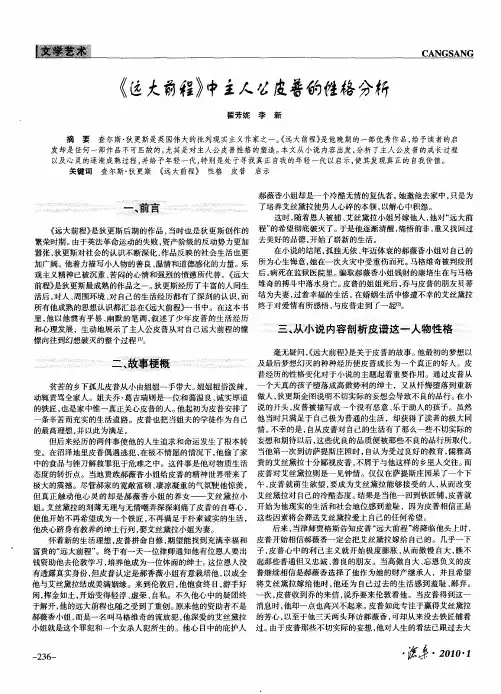
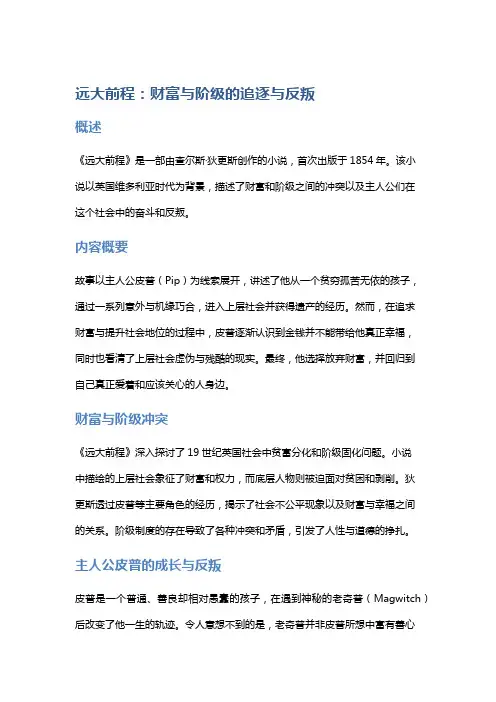
远大前程:财富与阶级的追逐与反叛概述《远大前程》是一部由查尔斯·狄更斯创作的小说,首次出版于1854年。
该小说以英国维多利亚时代为背景,描述了财富和阶级之间的冲突以及主人公们在这个社会中的奋斗和反叛。
内容概要故事以主人公皮普(Pip)为线索展开,讲述了他从一个贫穷孤苦无依的孩子,通过一系列意外与机缘巧合,进入上层社会并获得遗产的经历。
然而,在追求财富与提升社会地位的过程中,皮普逐渐认识到金钱并不能带给他真正幸福,同时也看清了上层社会虚伪与残酷的现实。
最终,他选择放弃财富,并回归到自己真正爱着和应该关心的人身边。
财富与阶级冲突《远大前程》深入探讨了19世纪英国社会中贫富分化和阶级固化问题。
小说中描绘的上层社会象征了财富和权力,而底层人物则被迫面对贫困和剥削。
狄更斯透过皮普等主要角色的经历,揭示了社会不公平现象以及财富与幸福之间的关系。
阶级制度的存在导致了各种冲突和矛盾,引发了人性与道德的挣扎。
主人公皮普的成长与反叛皮普是一个普通、善良却相对愚蠢的孩子,在遇到神秘的老奇普(Magwitch)后改变了他一生的轨迹。
令人意想不到的是,老奇普并非皮普所想中富有善心之人,而是一个逃亡囚犯。
尽管如此,老奇普给予了小男孩爱和金钱,并带领他走向上层社会。
然而,在远离家乡、接触到高尚世界中虚伪面纱后,皮普逐渐认识到金钱并不能购买真正的幸福,并意识到自己背叛了自己真正关心和珍视的人:乡村姑娘艾斯特拉(Estella)和养育自己的老姐夫乔·格尔吉斯(Joe Gargery)。
在真相浮出水面后,皮普决定与财富分手,并选择回到自己永远珍爱的人身边,展现了他的成长和内心的反叛。
反映社会问题狄更斯通过《远大前程》深刻反映了维多利亚时代英国社会面临的许多问题。
小说中描绘了曲折离奇却真实存在的社会环境、贫困、囚禁罪犯、剥削劳动者以及上层社会对底层人物的高傲与歧视等诸多问题。
通过揭示阶级固化、道德沦丧和虚伪等弊端,狄更斯呼唤着当时社会对于人性尊重、平等和正义的关注。
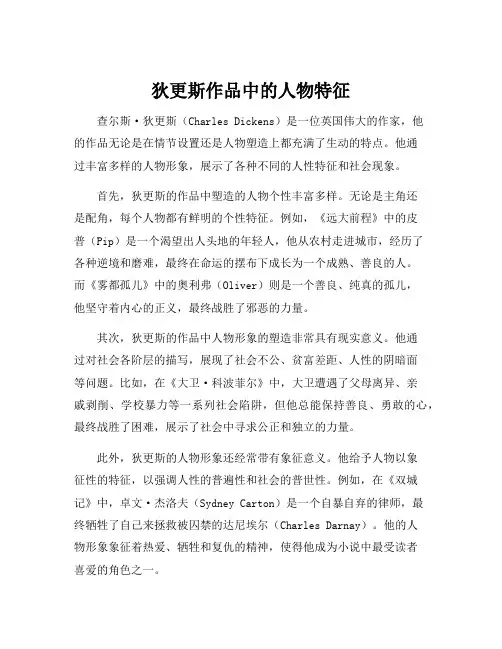
狄更斯作品中的人物特征查尔斯·狄更斯(Charles Dickens)是一位英国伟大的作家,他的作品无论是在情节设置还是人物塑造上都充满了生动的特点。
他通过丰富多样的人物形象,展示了各种不同的人性特征和社会现象。
首先,狄更斯的作品中塑造的人物个性丰富多样。
无论是主角还是配角,每个人物都有鲜明的个性特征。
例如,《远大前程》中的皮普(Pip)是一个渴望出人头地的年轻人,他从农村走进城市,经历了各种逆境和磨难,最终在命运的摆布下成长为一个成熟、善良的人。
而《雾都孤儿》中的奥利弗(Oliver)则是一个善良、纯真的孤儿,他坚守着内心的正义,最终战胜了邪恶的力量。
其次,狄更斯的作品中人物形象的塑造非常具有现实意义。
他通过对社会各阶层的描写,展现了社会不公、贫富差距、人性的阴暗面等问题。
比如,在《大卫·科波菲尔》中,大卫遭遇了父母离异、亲戚剥削、学校暴力等一系列社会陷阱,但他总能保持善良、勇敢的心,最终战胜了困难,展示了社会中寻求公正和独立的力量。
此外,狄更斯的人物形象还经常带有象征意义。
他给予人物以象征性的特征,以强调人性的普遍性和社会的普世性。
例如,在《双城记》中,卓文·杰洛夫(Sydney Carton)是一个自暴自弃的律师,最终牺牲了自己来拯救被囚禁的达尼埃尔(Charles Darnay)。
他的人物形象象征着热爱、牺牲和复仇的精神,使得他成为小说中最受读者喜爱的角色之一。
总之,狄更斯作品中的人物特征丰富多样,生动鲜活。
他不仅通过塑造个性鲜明的人物形象,展现了人性的善恶和复杂性,也通过对社会问题的描绘,呼吁读者关注社会现实。
他的作品不仅给予我们阅读的乐趣,更引导我们思考和反思,让我们了解到人性的多样性和社会问题的复杂性,并希望我们在现实生活中能够秉持善良、勇敢和正义的精神。
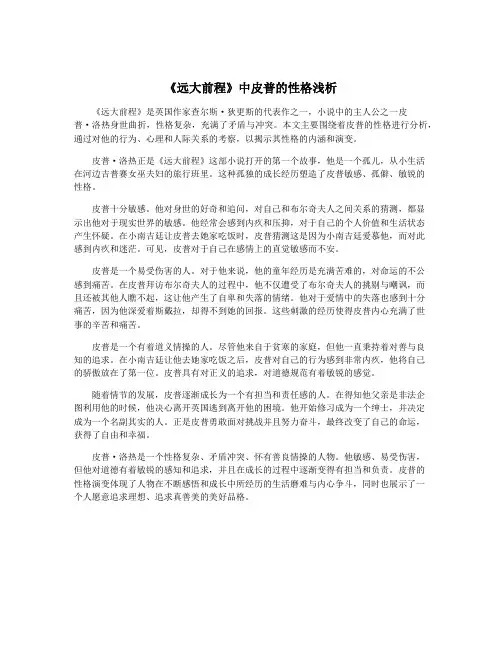
《远大前程》中皮普的性格浅析《远大前程》是英国作家查尔斯·狄更斯的代表作之一,小说中的主人公之一皮普·洛热身世曲折,性格复杂,充满了矛盾与冲突。
本文主要围绕着皮普的性格进行分析,通过对他的行为、心理和人际关系的考察,以揭示其性格的内涵和演变。
皮普·洛热正是《远大前程》这部小说打开的第一个故事,他是一个孤儿,从小生活在河边吉普赛女巫夫妇的旅行班里。
这种孤独的成长经历塑造了皮普敏感、孤僻、敏锐的性格。
皮普十分敏感。
他对身世的好奇和追问,对自己和布尔奇夫人之间关系的猜测,都显示出他对于现实世界的敏感。
他经常会感到内疚和压抑,对于自己的个人价值和生活状态产生怀疑。
在小南吉廷让皮普去她家吃饭时,皮普猜测这是因为小南吉廷爱慕他,而对此感到内疚和迷茫。
可见,皮普对于自己在感情上的直觉敏感而不安。
皮普是一个易受伤害的人。
对于他来说,他的童年经历是充满苦难的,对命运的不公感到痛苦。
在皮普拜访布尔奇夫人的过程中,他不仅遭受了布尔奇夫人的挑剔与嘲讽,而且还被其他人瞧不起,这让他产生了自卑和失落的情绪。
他对于爱情中的失落也感到十分痛苦,因为他深爱着斯戴拉,却得不到她的回报。
这些刺激的经历使得皮普内心充满了世事的辛苦和痛苦。
皮普是一个有着道义情操的人。
尽管他来自于贫寒的家庭,但他一直秉持着对善与良知的追求。
在小南吉廷让他去她家吃饭之后,皮普对自己的行为感到非常内疚,他将自己的骄傲放在了第一位。
皮普具有对正义的追求,对道德规范有着敏锐的感觉。
随着情节的发展,皮普逐渐成长为一个有担当和责任感的人。
在得知他父亲是非法企图利用他的时候,他决心离开英国逃到离开他的困境。
他开始修习成为一个绅士,并决定成为一个名副其实的人。
正是皮普勇敢面对挑战并且努力奋斗,最终改变了自己的命运,获得了自由和幸福。
皮普·洛热是一个性格复杂、矛盾冲突、怀有善良情操的人物。
他敏感、易受伤害,但他对道德有着敏锐的感知和追求,并且在成长的过程中逐渐变得有担当和负责。
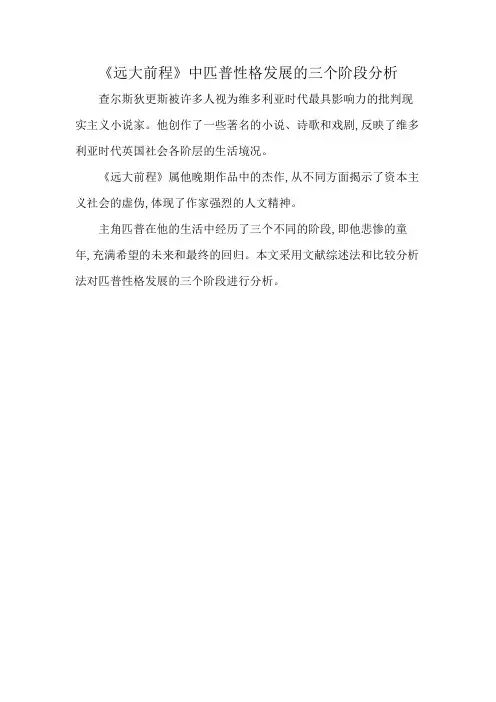
《远大前程》中匹普性格发展的三个阶段分析
查尔斯狄更斯被许多人视为维多利亚时代最具影响力的批判现实主义小说家。
他创作了一些著名的小说、诗歌和戏剧,反映了维多利亚时代英国社会各阶层的生活境况。
《远大前程》属他晚期作品中的杰作,从不同方面揭示了资本主义社会的虚伪,体现了作家强烈的人文精神。
主角匹普在他的生活中经历了三个不同的阶段,即他悲惨的童年,充满希望的未来和最终的回归。
本文采用文献综述法和比较分析法对匹普性格发展的三个阶段进行分析。
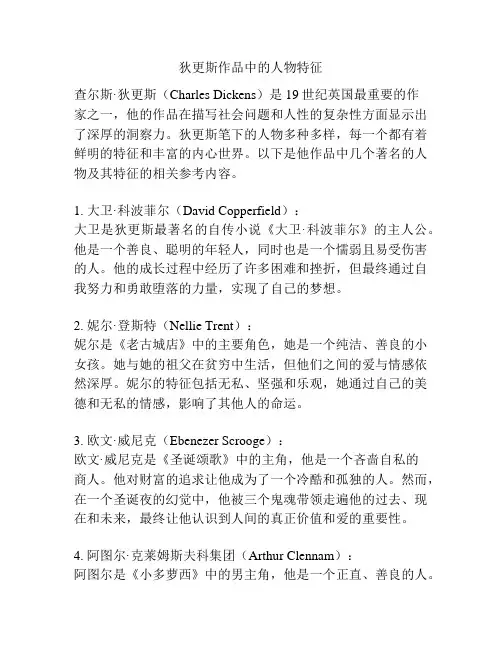
狄更斯作品中的人物特征查尔斯·狄更斯(Charles Dickens)是19世纪英国最重要的作家之一,他的作品在描写社会问题和人性的复杂性方面显示出了深厚的洞察力。
狄更斯笔下的人物多种多样,每一个都有着鲜明的特征和丰富的内心世界。
以下是他作品中几个著名的人物及其特征的相关参考内容。
1. 大卫·科波菲尔(David Copperfield):大卫是狄更斯最著名的自传小说《大卫·科波菲尔》的主人公。
他是一个善良、聪明的年轻人,同时也是一个懦弱且易受伤害的人。
他的成长过程中经历了许多困难和挫折,但最终通过自我努力和勇敢堕落的力量,实现了自己的梦想。
2. 妮尔·登斯特(Nellie Trent):妮尔是《老古城店》中的主要角色,她是一个纯洁、善良的小女孩。
她与她的祖父在贫穷中生活,但他们之间的爱与情感依然深厚。
妮尔的特征包括无私、坚强和乐观,她通过自己的美德和无私的情感,影响了其他人的命运。
3. 欧文·威尼克(Ebenezer Scrooge):欧文·威尼克是《圣诞颂歌》中的主角,他是一个吝啬自私的商人。
他对财富的追求让他成为了一个冷酷和孤独的人。
然而,在一个圣诞夜的幻觉中,他被三个鬼魂带领走遍他的过去、现在和未来,最终让他认识到人间的真正价值和爱的重要性。
4. 阿图尔·克莱姆斯夫科集团(Arthur Clennam):阿图尔是《小多萝西》中的男主角,他是一个正直、善良的人。
他的一生中遭遇了许多困难和不幸,但他从不放弃追寻真相和正义。
阿图尔的特征包括坚毅、勇敢和正直,他通过自己的努力,改变了自己的命运,最终找到了真爱和幸福。
5. 蒂尔尼夫人(Miss Havisham):蒂尔尼夫人是《远大前程》中的主要角色,她是一个受伤的女人,永远穿着婚纱、停滞在过去的世界中。
她的特征包括孤独、痛苦和复仇心理。
蒂尔尼夫人通过利用他人的感情来满足自己的需求,最终导致了自己的孤独和悲惨的命运。
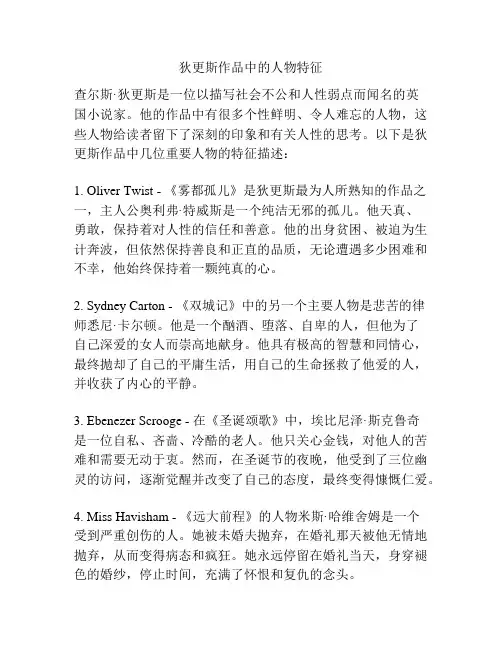
狄更斯作品中的人物特征查尔斯·狄更斯是一位以描写社会不公和人性弱点而闻名的英国小说家。
他的作品中有很多个性鲜明、令人难忘的人物,这些人物给读者留下了深刻的印象和有关人性的思考。
以下是狄更斯作品中几位重要人物的特征描述:1. Oliver Twist - 《雾都孤儿》是狄更斯最为人所熟知的作品之一,主人公奥利弗·特威斯是一个纯洁无邪的孤儿。
他天真、勇敢,保持着对人性的信任和善意。
他的出身贫困、被迫为生计奔波,但依然保持善良和正直的品质,无论遭遇多少困难和不幸,他始终保持着一颗纯真的心。
2. Sydney Carton - 《双城记》中的另一个主要人物是悲苦的律师悉尼·卡尔顿。
他是一个酗酒、堕落、自卑的人,但他为了自己深爱的女人而崇高地献身。
他具有极高的智慧和同情心,最终抛却了自己的平庸生活,用自己的生命拯救了他爱的人,并收获了内心的平静。
3. Ebenezer Scrooge - 在《圣诞颂歌》中,埃比尼泽·斯克鲁奇是一位自私、吝啬、冷酷的老人。
他只关心金钱,对他人的苦难和需要无动于衷。
然而,在圣诞节的夜晚,他受到了三位幽灵的访问,逐渐觉醒并改变了自己的态度,最终变得慷慨仁爱。
4. Miss Havisham - 《远大前程》的人物米斯·哈维舍姆是一个受到严重创伤的人。
她被未婚夫抛弃,在婚礼那天被他无情地抛弃,从而变得病态和疯狂。
她永远停留在婚礼当天,身穿褪色的婚纱,停止时间,充满了怀恨和复仇的念头。
5. Fagin - 《雾都孤儿》的反派角色费金是一个诱导孩子进入犯罪道路的恶势力之一。
他是一个精明的小偷头子,利用孤儿和孩子们为他窃取财富。
他聪明、残忍,并试图将奥利弗招募为自己的手下。
费金是一个丑陋而邪恶的人物,展示了那些为了财富和权力而不择手段的黑暗一面。
这些角色特征的描述只是表面上的概括,每个角色都有诸多层次的复杂性和矛盾性,他们带有强烈的人性特征和情感冲突。

摘要查尔斯·狄更斯(1812-1870)是十九世纪英国最杰出的小说家之一,也是第一位倾注了极大精力创造儿童形象的大作家,他塑造的许多儿童形象在世界文坛上有着不可超越的重要意义。
本文通过分析他的三部代表作品《雾都孤儿》、《大卫·科波菲尔》、《远大前程》中的儿童形象,探讨这些形象与作者的密切关系。
首先这类儿童形象的塑造都与狄更斯的个人经历特别是童年经历或所处的社会背景有关;其次,通过这些儿童形象的塑造,狄更斯在反映其童年经历的同时,也记录了社会的黑暗,并且展示了他对资产阶级黑暗性不断觉醒的过程。
本论文试图从比较分析的角度,从三部作品中抽取有代表性的章节进行研究,分析他个人经历与三位主人公的联系,体现出他对笔下儿童的深切情感,并得出狄更斯在塑造儿童形象方面的共性。
关键词:狄更斯;儿童形象;分析;共同特征ABSTRACTCharles Dickens(1812-1870)is one of the most outstanding English writers in the nineteenth century. He is also the first writer who devoted himself to the creation of children‘ imagines. The images of children created by Charles Dickens play a very important role in the world literature. By comparison, this paper discusses the relationship between the author and these images. Firstl y, the creation of these children‘s images has a close connection with Dickens‘ personal experience and social background; secondly, by the creation of these images he reveals the darkness of society, and shows his growing awareness of the darkness of the capitalism. Through the analysis, this paper draws the common features in Charles‘ creation of children‘s imagines. And through the research of the representative chapters, the deep emotions between Dickens and his children can be vividly shown.Keywords:Dickens; Children‘s images; Analysis; Common FeaturesContents1. Introduction (1)1.1The introduction of the author (1)1.2The introduction of children‘s images (1)2. Analysis of the three main children’s images in Dickens’ novels (3)2.1Oliver Twist: Dickens‘ own want in his childhood (3)2.2David Copperfield: Dickens‘ own sufferings in his childhood (5)2.3Great Expectations: Dickens‘ growing awareness of c apitalism‘s darkness (7)3. The comparison of three children’s images in three novels (10)3.1 The similarities of the three children (10)3.1.1 The circumstances (10)3.1.2 The tragedy childhood (10)3.2 The relationship between Dickens and the three children (11)3.2.1 The similar childhood experiences (11)3.2.2 The sympathy for the children and the criticism for social evils (11)3.2.3 The common styles in children‘s images figuring (12)4. Conclusion (13)Acknowledgements (14)References (15)1. Introduction1.1 The Introduction of the AuthorCharles Dickens(1812-1870)is one of the most outstanding English writers in the nineteenth century. He was born in Portsmouth, England on 7th, February, 1812, but he spent most of his childhood in London and Kent where he based many of his novels. When he was nine,he went to school but had to leave when he was 12 because his dad was put in prison for being in debt. When he was 15,he left school and went to work as a legal clerk in a solicitor's office. In 1836 he decided to write his own stories under the name of Boy. They were called the“Pickwick Papers”[1]which were like comics for adults. Charles continued to use his books to tell about the bad conditions that the working classes and poor people had to live with. As well as writing he took an interest in the theatre and in 1847 became manager of a touring theatre company. Charles Dickens wrote many famous novels all his life, he is probably the most popular author in England.1.2 The Introduction of Children‘s Images in His NovelsCharles Dickens‘ work s enjoy great popularity among people and can stand the test of time. Even in 21st century, his works are still widely read, continuously translated into many languages and adapted into films and TV series. Dickens‘ vivid description creates many lifelike characters, which impress the readers deeply in their memory after reading.Among children‘s images created by Charles Dickens, deserted children play the most significant roles. It is important to point out that the creation of the deserted children has a close rel ationship with both Dickens‘personal experience and social background, especially his childhood experience. His fiction attracts many readers. These children were described so vividly that as if they were really alive in the world.―Dickens appeals to the common experience of the reader.‖ [2]So the reader is easily able to identify the different images in his different novels. For example, of all his works, David Copperfield is considered to be his most autobiographical. In this novel, Charles creates an orphan just like him, and through this character, he describes the memory about his own childhood and expresses the sympathy for the poor people. And in Great Expectations he really puts his own heart and soul into his characters by weaving his own experiences into his works.Philip Collins writes ―Great Expectations,indeed, though overtly autobiographical than David Copperfield, is a more searching and self-critical account of Dickens' own inner impulses.‖[3]It is almost as if there is a real possibility that Pip, or someone like him, actually existed. Another example is in Oliver Twist. Oliver is a kind of children that orphans or half-orphans who are deserted, or simply neglected. He lacks warm family love when he is very young. All of the deserted children in the novels have a miserable childhood and long for care and love from adults. As Charles‘ own childhood experience is miserable, he can contribute to his views on social reform, and his compassion for the lower class, especially the children.2.Analysis of the ThreeMain Children’s Images in Dickens’ Novels2.1Oliver Twist: Dickens‘ Own Want in His Childhood“Please, sir, I want some more.”The master was a fat healthy man; but he turned very pale. He gazed in stupefied astonishment on the small rebel for some seconds, and then clung for support to the copper. The assistants were paralyzed with wonder; the boys with fear.“What!” said the master at length, in a faint voice.“Please, sir, ”replied Oliver,“I want some more.”The master aimed a blow at Oliver’s head with the ladle, pinioned him in his arms, and shrieked aloud for the beadle.The Board were sitting in solemn conclave, when Mr. Bumble rushed into the room in great excitement, and addressing the gentleman in the high chair, said: “Mr. Limpkins, I beg your pardon, sir! Oliver Twist has asked for more!” There was a general start. Horror was depicted on every countenance.“For more! ”said Mr.Limpkins .“Compose yourself,Bumble, and answer me distinctly. Do I understand that he asked for more, after he had eaten the supper allotted by the dietary?”“He did,sir,”replied Bumble. “That boy will be hung,”said the gentleman in the white waistcoat. “I know that boy will be hung.” [4]In this scene, a hungry boy is asking for more claims universal admiration. The poor boy‘s image is vividly appearing on the paper. And this situation evokes in the readers a strong sense of sympathy towards the boy and a strong sense of horror against the system. This is one of Charles‘ famous novels which is entitled Oliver Twist.Oliver Twist, published in 1838, is one of Charles Dickens's best-known and well-loved works. After it was published, it was popular among England. ―Dickens used the characters and situations in the book to make a pointed social commentary, attacking the hypocrisy and flaws of institutions, including his society‘s government,its laws and criminal system, and its methods of dealing with poor people.” [5]Interestingly, he did not suggest any solutions; he only pointed out the suffering which caused by these systems and their deep injustice. Dickens basically believed that most people were born good but that their good impulses could be distorted by social evils.The scene of Oliver‘s asking for more is Dickens‘ recall of his chil d labor‘s life. As the author of the novel, he knew clearly about the cold impersonality of the workhouse system. His childhood suffering dominates the whole style of his writing and the whole view to society later. ―Dickens used his artistic talents to sp eak for the silence, to fight for the oppressed, and to champion those defeated.‖[6]Meanwhile he showed his great sympathy for the miseries and hardships suffered by the working class people. According to Doris Alexander, Dickens―knew that early circumsta nces shape character and that character, in turn, shapes reactions to later circumstances.‖[7]And in many ways, that character successfully drew attention and sympathy from their readers. In Dickens‘ works he gave children a voice that they desperately needed, yet never had before. Maybe some readers will wonder why Dickens always makes the world weigh so heavy on the little shoulders of his characters. The main reason is that he wanted to protest against the injustices toward children that he saw in his own childhood. He used his own experience to illustrate what these children needed and what they were missing. His childhood‘s recall has totally reflected in Oliver Twist.Oliver Twist is also Dickens‘first novel that focused on a child hero, whose experiences expressed Dickens‘ psychological want in childhood. Throughout the novel, Dickens used Oliver‘s character to challenge the Victorian age‘s evil. He was tortured and mistreated in the workhouse at his early age, later was thrown together with the band of thieves, he suffered a lot of pain but his kind nature remained unchanged. Dickens tried to create a child who did not present a complex picture between good and evil—instead, he was goodness all the time. What carried Oliver through life and away from the poverty was his good nature. Dickens himself had to work in the workhouse as young as Oliver. As a deserted child, Dickens hungered for love and help from adults. So in Oliver Twist, Dickens created several kinds encounters to offer help which freed Oliver from sufferings and dangers to a penniless and hopeless child. From these images, we may see Dickens himself as a lonely and deserted child who is eagerly expecting kind encounter with good-hearted men by whom he will be offered help. So these happy encounters are author‘s psychological want in his childhood.In the novel Oliver understood the life forms well, and this helped him fit the society better. He began his life misery enough—orphaned, underfed, unloved, beaten, apprenticed, fed the scraps the dog scorns, and made to sleep in the shop with the coffins at night. We are impressed deeply by the description of workhouse and undertaker‘s shop through Oliver‘s view .In his eyes the world was cruel and awful. ―Dickens draws strictly from hisobservat ion from Oliver‘s view, giving us the very truth in despite of sentiment.‖[8]Passing from the shadow of the workhouse to that of criminal London, we can feel that London is a place of squalid mystery and terror, of the grimly grotesque, of labyrinthine obscurity and lurid fascination. He taught people a certain way of regarding the huge city, the dirty streets, accurately described and named; the bare, filthy rooms inhabited by Fagin and Sikes and the rest of them; the hideous public-house to which thieves resort. Through the directly touch with the huge city, we have a very scared impression, for instance, what the working class people eat and drink, and can smell the dish of sheep's head, flank with porter, which Nancy sets before her brutal companion. ―In Dickens‘s case, he managed to use this gruel story as a means to shift his long stored tensions into the image of Oliver Twist, producing thus a metaphoric account that could function quite like a dream.‖ [9]2.2David Copperfield: Dickens‘ Own Sufferings in His Childhood“The room was as neat as Janet or my aunt. As I laid down my pen, a moment since, to think of it, the air from the sea came blowing in again, mixed with the perfume of the flowers; and I saw the old-fashioned furniture brightly rubbed and polished, my aunt's inviolable chair and table by the round green fan in the bow-window, the drug get-covered carpet, the cat, the kettle-holder, the two canaries, the old china, the punch-bowl full of dried rose leaves, the tall press guarding all sorts of bottles and pots, and, wonderfully out of keeping with the rest, my stained and dusty self upon the sofa, taking note of everything, Janet had gone away to get the bath ready, when my aunt ,to my great alarm, became in one moment rigid with indignation, and had hardly voice to cry out, "Janet!Donkiesr!"Upon which, Janet came running up the stairs as if the house were in flames, darted out on a little piece of green in front, and warned off two saddle-donkeys, lady-ridden, that had presumed to set hoof upon it; while my aunt, rushing out of the house, seized the bridle of a third animal laden with a bestriding child, turned him, led him forth from those sacred precincts, and boxed the cars pf the unlucky urchin in attendance who had dared to profane that hallo wed gr ound.” [10]David Copperfield is the most unique book among all Dickens‘ works for its deeply personal tone; it is an autobiography of the author himself and also a history of Dickens‘emotional life. This novel was created in 1849-1850, midway in his career, just before the writing of the ―dark‖novels. In this story, Dickens describes a very lovely boy namedDavid Copperfield. ―I am within three pages of the shore,and am strangely divided, as usual in such cases, between sorrow and joy. Oh, my dear Forster, if I were to say half what ‗Copperfield‘ makes me feel to-night, how strangely, even to you; I should be turned inside out! I seem to be sending some part of myself into the Shadowy World.‖ [11]Charles Dickens wrote in a letter just before he finished the final chapter of David Copperfield. And he became intensely involved in this character while he was writing. And in 1869, the year before he died, Dickens wrote that Copperfield was still his ―favorite child.‖[12] David Copperf ield‘s whole life can be divided into three stages. In the first stage he had a miserable childhood. He was born at Blunder stone, six months after his father‘s death. David spent his happy early days with his mother, Clara Copperfield, a gentle but weak woman, and Peggotty, the combination servant and nurse. When his mother married again, to a Mr. Murdstone, his miserable life had begun. He was imaginative and sensitive, suffering more from psychic anguish than from physical abuse. David flourished and expanded under affection, but shriveled and contracted deprived of it. And in the second stage, David was packed off to Salem House School near London. This institution was run by the ferocious Mr. Creakle, a sadist. But the worst thing is his mother and her newborn baby died and loyal Peggotty was dismissed by his stepfather, David was really lonely and deserted. He was sent to the warehouse in London, which followed, was worse. No one loved him and no one cared for him. There, half-starved, the 10-year old David labored beside slum urchins. Finally he couldn‘t stand the torture and decided to run away from the warehouse. He made his way on foot to Dover where Aunt Betsey Trotwood, his only living relative. Fortunately, his aunt took him in and sent him to Canterbury to attend a school. The next is the third stage, David experiences and comforted for his happy new start. David survived his ordeal with the moral support of several adults: the Micawbers, Aunt Betsey, and Dr. Strong, who educated him. He discovered enormous reserves of strength within, a dogged perseverance which enabled him to master the difficult art of shorthand reporting. This trait stood him in good stead when he became a writer, and was the key to his later success.Dickens figures this character very well. That is all due to his childhood sufferings. Dickens was brought up by middle-class parents. But then he was abandoned as worthless. The few shillings a week he earned barely served for his keep, so that his sacrifice seemed gratuitous, a means of getting him out of the way. The blacking factory left him with a lifelong insatiable need for recognition and approval; a degree of emotional reserve; and an obsession with cleanliness and order which he himself admitted was ―almost adisorder‖.[13]He was haunted by the experience for the rest of his life. ―Even now, famous and caressed and happy, I often forget in my dreams that I have a dear wife and children; even that I am a man; and wander desolately back to that time of my life.‖[14]The Christmas before his death, playing a ―memory game‖with his family, Dickens wrote down,―Warren‘s Blacking,30, Strand‖[15],which meant nothing to his children until his biography was published after his death.Dickens also conveys his view of education in David Copperfield. David was first educated informally at home. He learnt the ―alphabet at his mother‘s knee‖[16] and read to Peggotty from the Crocodile book, developing his imagination–―we went into the water…and put sharp pieces of timber down their throats‖[17]Dickens clearly approves of this education, so in the novel David said in retrospect that memories of this time ―recall no feeling of disgust or reluctance‖[18]Dickens contrasts the misery of David‘s education after his mother‘s remarriage; ―David w as betrayed by his own nervousness in front of the dominating Murdstones, upsetting his mother and lowering his self-esteem–he seemed to be more stupid.‖[19]This negative effect again showed Dickens‘ encouragement of a very different form of education. David was not ―stupid‖ and it was only the strict and stifling circumstances that made him feel this way. If the Murdstones were more liberal and generous in their education, the results would be totally different. Dickens‘views on education are conveyed bes t through the contrast between Betsey Trotwood‘s firmness and Mr. Murdstone. ―David never to be mean in anything, never to be false and never to be cruel.‖[20]His epic journey showed the consequences of these educational methods; David was literally escaping the moral, physical and financial imprisonment of the factory, and got the freedom to explore and develop his interests at last.2.3Great Expectations: Dickens‘Growing Awareness of C apitalism‘sDarkness“My sister,Mrs. Joe Gargery, was more than twenty years older than I, and had established a great reputation with herself and the neighbors because she had brought me up“ by hand.” Having at that time to find out for myself what the expression meant, and knowing her to have a hard and heavy hand, and to be much in the habit of laying it upon her husband as well as upon me, I supposed that Joe Gargery and I were both brought up by hand.It is a most miserable thing to feel ashamed of home. There may be black ingratitudein the thing, and the punishment may be retributive and well deserved; but, that it is a miserable thing, I can testify. Home had never been a very pleasant place to me, because of my sister's temper. But, Joe had sanctified it, and I had believed in it. I had believed in the best parlors as a most elegant saloon; I had believed in the front door, as a mysterious portal of the Temple of State whose solemn opening was attended with a sacrifice of roast fowls; I had believed in the kitchen as a chaste though not magnificent apartment; I had believed in the forge as the glowing road to manhood and independence. Within a single year, all this was changed. Now, it was all coarse and common, and I would not have had Miss Havisham and Estella sees it on any account.” [21]Great Expectations first appeared in Charles Dickens‘weekly journal ―All the Year Round” in 1861,and then came out in book form in 1862.One of the most important and common tools that authors use to illustrate the themes of their works is a character that undergoes several major changes throughout the story. As a book which was written in the afternoon of Dickens's life and fame, the great difference between Great Expectations and his earlier novels is the introduction of dramatic psychological transformations. He introduces the readers to many intriguing and memorable characters including Miss Havesham, Mr.Jaggers, and the benevolent convict, Abel Magwitch.In common sense, the children's world should be filled with tender care and happiness; it should be a worry-free world.In Great Expectations, however,Pip's world could not be described as such.He was an orphan living in the changing moods, cruelty and violence of his sister and Uncle Pumblechook. Such living conditions resulted in a timid and sensitive Pip. Joe was the only one who took care of Pip. He treated Pip as his dear friend and gave Pip sincerity and comfort. He led Pip to realize there was happiness and warmth in life even though his influence was too weak to combat Mrs. Joe and Uncle Pumblechook. But the false values about money and social status penetrated into Pip's world, Pip could not resist it and therefore lost balance in mind. So his simple dream changed. He vainly expected to be a gentleman, to marry Estella. Subjected to such wrong ideas, Pip lived in the gap between reality and dream.Although in such terrible circumstances, Pip's still have industrious, kind, simple element in his mind, this is mainly due to Joe. Joe was Pip's comfort and source of happiness. Joe represented the virtues of the working class. In bringing Pip up, Joe's attitude was quite different from others. He sincerely did all he could for Pip. He was Pip's fellow-sufferer. He never looked down and maltreated Pip, but protected Pip from Mrs.Joe's bullying. Pip was deeply moved by such sincere care; and therefore Pip had gratitude for Joe. The most important thing he told Pip was to be honest:"There's one thing you may be sure of, Pip," said Joe, after some rumination, "namely, that lies is lies. However they come, they didn't need to come, and they come from the father of lies, and work round to the same. Don't you tell no more of them, Pip. That ain't the way to get out of being common, old chap. And as to being common, I don't make it out at all clear. You are on common in some things. You're on common small .Likewise you're on common scholar. [22]But when Pip met Estella, he was strong attracted by her. He longed for Estella but was laughed at by this beautiful proud girl. From then on, Pip felt ashamed of his hands, of his boots, of his social status and friends. He fell into false values. His ambition to be a gentleman resulted from his hopeless love for Estella. The worship of money and was like poison. Pip was trapped in his dreams. ―It is reasonable to believe, in this case, that Great Expectation is a novel focusing on the sense of disillusionment of one‘s ideal, dream and aspiration. This echoes, however, the author‘s own traumatic experience of being disillusioned on a personal basis and eventually on a social level. His pursuit for his own identity in the society is a disillusionment that results in his constant anxiety and frustration, which underlies the motives for Great Expectation.‖[23]Dickens and Pip have three similarities at least: the first one is the miserable childhood; the second one is the way to fulfill the dream. As for Pip, his life changed because of a mysterious benefactor. How Dickens ended his days in the blacking factory? After his father John Dickens inherited a fortune from a Scotch cousin, he was released from prison. As he had promised, Dickens was sent to school. So to speak, Dickens began his way to be a gentleman. The last but not the least one is the growing awareness of the influence of capitalism. Pip began his adventure as a gentleman when he left the forge of Joe and lived in the circle of gentlemen in London. In the Victorian Age, London was not as good as Pip imagined. Here, Pip lost his good nature for a time and felt proud of being a dandy. He turned into a selfish, blinkered, frivolous one. He fell even deep into the illusions that Miss Havisham was his benefactor and he would marry Estella under the authority of Miss Havisham. The suddenly coming-back of Magwitch broke his illusions into pieces and made him realize his misdoings. He decided to get rid of illusions and his gentleman life.The novel charts the career of Philip Pip, from blacksmith‘s boy to polished gentleman, driven by his hope of winning the hand of his first love, Estella.He haschanged from an innately jolly and optimistic man into one who is disillusioned and pessimistic.Dickens shows his philosophic idea clearly through this novel and figure out a classic child‘s image.3.The Comparison of The ThreeChildren’s Images in Three Novels3.1 The Similarities of the Three ChildrenIn these three famous novels, Dickens created three vivid children‘s images. They are all orphans or half-orphans, have a tragedy childhood, all of them are tinged with a tone of autobiography. And comparing these children‘s images, we may find out that the circumstance and the tragedy childhood are the most similar things.3.1.1 The circumstancesFrom the three novels, it‘s evident that the three boys are boxed up by the dark and hopeless society. They lost their parents, not treated well by their keepers. However, the important plot shared by the three novels is that all the boys undergo a dramatic change of life by receiving unexpected sponsorship from either their relatives or people around them. Oliver Twist was helped by Mr. Brownlow, who turned out to be a friend of his father‘s and one who eventually got back for Twist the legacy that belonged to him. David sought help from Aunt Betsey, with whose money he received decent education until he could live on his own. Pip, on the other hand, received unexpected legacy from an anonymous ―gentleman‖, who turned out to be the criminal he once helped. They go through a lot of hardships during their life. Fortunately, despite all the hardships and torture they experience, the deserted children keep their good nature all their lives.3.1.2 The tragedy childhoodOliver Twist, David Copperfield and Pip are all orphaned children, brought up by either their relatives or governmental institutions. Twist was fatherless and his mother died after giving birth to him. David was also fatherless. He was brought up by his mother until his mother sent him away for her re-marriage. Pip was parentless; he was, from thebeginning of the story, an orphaned child living with his sister and her husband. When they grow up, all of them experience lonely and hard trips to find new hopes in life. In Oliver Twi st, Twist escaped from the Sowerberry‘s house to London due to the mistreatment he received from a charity boy Noah Claypole, who goads him to rebellion. In David Copperfield, young David made his way on foot to Dover where Aunt Betsey Trotwood, his only living relative resides. In Great Expectations, however, Pip went to London in a buoyant manner due to his inheritance of a large amount of money from an anonymous benefactor. Although the trips are not entirely of the same desperation, they have reviewed, in the same manner, about the sorrow at departure, the sense of extreme loneliness, as well as the feeling of abandonment.3.2 The Relationship Between Dickens and Three BoysThe creation of deserted children has a close relationship with Dickens‘personal background especially his childhood experience. The important reason of these novels can be so famous that they are vividly in the book, as if they are alive in the world .They can exist in readers mind so long, one hand is due to Dickens‘genius description, the other hand is that what these boys suffer in the book is also the memory of Dickens himself. 3.2.1 The similar childhood experiencesIn Dickens‘s novels, the boys are usually abandoned, this is all based upon his traumatic experience. The fact that the author could not retreat to his traumatic stage of life in reality causes him to find ways to regress to his traumatic childhood. The regressive impulses find a nice outlet in his novels. There, Dickens speak out lavishly his sorrow and agonies through the agent of his boy protagonists like a child who cried over and over again at his wound, knowing that he would feel much better after so doing.That is perhaps what Dickens personally experienced in his childhood and this impression obviously leaves a permanent imprint on his mind. ―The long repressed loneliness and senses of abandonment find their way in his fiction. They are stirred alive from the unconscious level, heading for the conscious, during which the author reconciles himself to his traumatic experience and receives his salvation.‖[24]The significance of creating a necessary detail depicting the loneliness of the protagonists is more emotional than practical. Through the process of writing, Dickens relived his own dark experience and began his painful process to accept them as part of his life.Dickens‘s own drastic change in life—when he felt desperate about his own prospect, when he was plagued by the menial toil at the blacking house, his father received an。
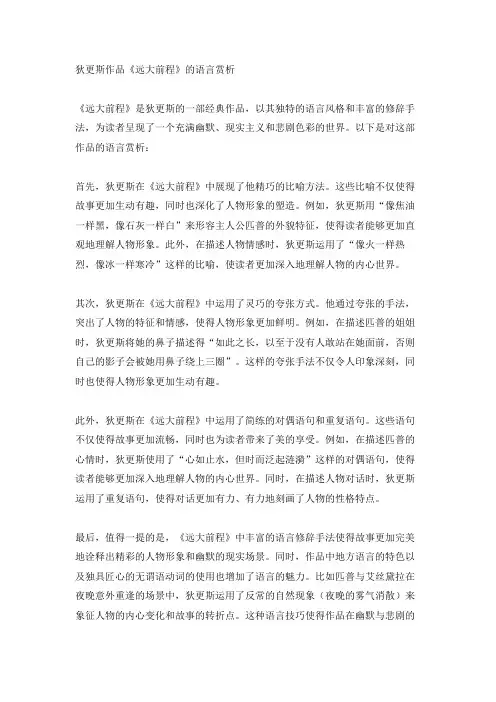
狄更斯作品《远大前程》的语言赏析《远大前程》是狄更斯的一部经典作品,以其独特的语言风格和丰富的修辞手法,为读者呈现了一个充满幽默、现实主义和悲剧色彩的世界。
以下是对这部作品的语言赏析:首先,狄更斯在《远大前程》中展现了他精巧的比喻方法。
这些比喻不仅使得故事更加生动有趣,同时也深化了人物形象的塑造。
例如,狄更斯用“像焦油一样黑,像石灰一样白”来形容主人公匹普的外貌特征,使得读者能够更加直观地理解人物形象。
此外,在描述人物情感时,狄更斯运用了“像火一样热烈,像冰一样寒冷”这样的比喻,使读者更加深入地理解人物的内心世界。
其次,狄更斯在《远大前程》中运用了灵巧的夸张方式。
他通过夸张的手法,突出了人物的特征和情感,使得人物形象更加鲜明。
例如,在描述匹普的姐姐时,狄更斯将她的鼻子描述得“如此之长,以至于没有人敢站在她面前,否则自己的影子会被她用鼻子绕上三圈”。
这样的夸张手法不仅令人印象深刻,同时也使得人物形象更加生动有趣。
此外,狄更斯在《远大前程》中运用了简练的对偶语句和重复语句。
这些语句不仅使得故事更加流畅,同时也为读者带来了美的享受。
例如,在描述匹普的心情时,狄更斯使用了“心如止水,但时而泛起涟漪”这样的对偶语句,使得读者能够更加深入地理解人物的内心世界。
同时,在描述人物对话时,狄更斯运用了重复语句,使得对话更加有力、有力地刻画了人物的性格特点。
最后,值得一提的是,《远大前程》中丰富的语言修辞手法使得故事更加完美地诠释出精彩的人物形象和幽默的现实场景。
同时,作品中地方语言的特色以及独具匠心的无谓语动词的使用也增加了语言的魅力。
比如匹普与艾丝黛拉在夜晚意外重逢的场景中,狄更斯运用了反常的自然现象(夜晚的雾气消散)来象征人物的内心变化和故事的转折点。
这种语言技巧使得作品在幽默与悲剧的色彩之间取得了完美的平衡。
综上所述,《远大前程》作为狄更斯的经典之作,其语言风格和修辞手法展现出了独特的魅力。
通过精巧的比喻、灵巧的夸张、简练的对偶语句和重复语句以及丰富的语言修辞手法,狄更斯成功地塑造出了一系列鲜活的人物形象和幽默的现实场景。
《远大前程》中皮普的性格浅析《远大前程》是英国作家查尔斯·狄更斯创作的一部长篇小说,通过描写主人公皮普的生活经历,展现了19世纪英国社会的丑恶和不公。
皮普作为小说的主要人物之一,其性格深受读者喜爱。
下面我将对皮普的性格进行浅析。
皮普是一个心地善良的人。
从小皮普就有着赤子之心,对他人充满了同情心和善意。
在小说中,无论是对待悲惨的孤儿休里,还是对待遭受欺骗的斯戴利,皮普都给予了最大的关心和帮助。
他不仅用心倾听他人的苦衷,还积极为他们提供援助,尽自己所能去改善他人的困境。
他的善良和同情心让他在读者心中成为一个可敬可爱的人物。
皮普是一个矛盾的人。
尽管他有着善良的心灵,但他却经常困扰于自身的内心斗争。
在成为一个绅士之后,皮普开始追求上流社会的地位和财富,但同时又感到内心的愧疚和矛盾。
他对自己的出生和社会地位感到羞耻,试图通过改变自己的外貌和举止来逃避自己的身世。
无论皮普怎样努力,他的内心矛盾和不安却无法摆脱。
皮普的矛盾性格给他的生活带来了许多困惑和折磨,也使读者对他的命运产生了深深的同情。
皮普是一个坚持自我并不断成长的人。
面对珍妮的背叛和生活的挫折,皮普并没有放弃希望和自信,而是通过坚强的意志和努力,逐渐摆脱了过去的困境。
在过程中,他不断学习、成长和改变,逐渐成为一个有责任感和考虑周全的人。
皮普在与斯戴利的交往中,从最初的盲目崇拜转变为痛定思痛,学会了如何审视和辨别他人的真实面目。
通过种种经历,皮普不仅意识到了自己的缺点和错误,还学会了坚持自我和追求真理的重要性。
皮普是一个心地善良、矛盾而又坚持自我成长的人物。
他的性格和经历让读者深刻体会到了人性的复杂性和社会的不公正。
皮普的形象也给予了我们启示,即要善良对待他人,要坚持追求真理与自我成长。
《远大前程》中皮普的性格浅析《远大前程》是英国作家查尔斯·狄更斯的一部经典小说,讲述了一个贫穷少年从事劳动阶级工作,艰难地实现自己的远大梦想的故事。
其中一个重要人物是皮普(Pip),他的性格经历了不断的成长和转变。
皮普是一个孤儿,从小生活在谢德厦尔夫人(Mrs. Joe)和她的哥哥乔·格吕格尔斯(Joe Gargery)那里。
在他们的夫妻关系中,乔是唯一对皮普关心和关爱的人。
与乔形成鲜明对比的是,谢德厦尔夫人对待皮普十分苛刻和残酷。
皮普的性格一开始比较屈从和忍让。
在谢德厦尔夫人的家中,皮普总是要承受谢德厦尔夫人毒舌的责骂和殴打。
他在家中缺乏关爱,而在乔的陪伴下是充满温暖和快乐的。
这种环境下,皮普变得胆小、消极,对自己的境遇非常愤懑。
皮普的性格在遇见了两个人物后发生了巨大的变化。
首先是遇见了哈维什姆小姐(Miss Havisham),一个生活在凄冷废弃的古堡里的女人。
在哈维什姆小姐那里,皮普受到了不同于谢德厦尔夫人的关爱,他经历了一个逐渐觉醒的过程,在他的内心中产生了对未来的美好憧憬和热望。
第二个人物是马奎斯(Magwitch),一个逃亡囚犯。
马奎斯是皮普遥远的亲戚,并且与他建立起相互帮助和理解的关系。
皮普不断帮助马奎斯,而马奎斯也用他积攒的财富帮助皮普实现了他的梦想。
通过这段经历,皮普逐渐认识到,人的价值不仅仅在于社会地位和财富,更重要的是人的内在品质和对他人的关心与帮助。
随着故事的发展,皮普的性格逐渐成熟并变得积极向上。
他意识到自己追求财富和地位的行为是虚假和浮躁的,最终明白了人真正需要的是内心的满足和对他人的关怀。
他通过各种经历,包括经济的失败和痛苦的失望,逐渐培养了对生活的深刻理解和关爱。
最终,他放弃了自己虚荣的欲望,选择了真爱,体现出他善良、坚强和高尚的性格。
皮普是一个经历了磨难而成长的角色。
他从一个胆小、屈从的少年逐渐成为一个善良、坚强的人,通过各种经历,他学会了关心他人、珍惜友情和追求内心的美好。
《远大前程》中艾丝黛拉是怎样的人物形象分析(最新版)编制人:__________________审核人:__________________审批人:__________________编制单位:__________________编制时间:____年____月____日序言下载提示:该文档是本店铺精心编制而成的,希望大家下载后,能够帮助大家解决实际问题。
文档下载后可定制修改,请根据实际需要进行调整和使用,谢谢!并且,本店铺为大家提供各种类型的经典范文,如诗歌散文、原文赏析、读书笔记、经典名著、古典文学、网络文学、经典语录、童话故事、心得体会、其他范文等等,想了解不同范文格式和写法,敬请关注!Download tips: This document is carefully compiled by this editor.I hope that after you download it, it can help you solve practical problems. The document can be customized and modified after downloading, please adjust and use it according to actual needs, thank you!In addition, this shop provides you with various types of classic sample essays, such as poetry and prose, original text appreciation, reading notes, classic works, classical literature, online literature, classic quotations, fairy tales, experience, other sample essays, etc. if you want to know the difference Please pay attention to the format and writing of the sample essay!《远大前程》中艾丝黛拉是怎样的人物形象分析【导语】:艾丝黛拉是《远大前程》中重要的人物,关于艾丝黛拉是怎样的人一直受到关注,来了解一下艾丝黛拉的人物形象吧。
远大前程的历史背景与人物塑造1. 背景介绍《远大前程》是一部19世纪英国作家查尔斯·狄更斯创作的长篇小说,首次出版于1850年。
这部小说通过描写工业革命时期伦敦贫民窟中贫寒孤苦的孩子菲利普·皮林斯(Philip Pirrip)的成长经历,展现了当时社会阶级差距、人性黑暗与光明之间的冲突。
在分析《远大前程》的历史背景时,不可忽视以下几个重要方面:1.1 工业革命与社会变革19世纪是英国工业革命的高峰期,工业化进程对社会产生了深远影响。
城市化速度加快、工厂普遍兴起,贫穷、污染和犯罪呈现上升趋势。
这种社会变革为小说中描绘的贫民窟背景提供了必要条件。
1.2 阶级问题与社会不公工业革命带来了剧烈的阶级分化和财富差距加大。
贫穷的工人阶级面临着生活困境,而富人则享受着财富和特权。
这种社会不公是小说中主要冲突的核心。
1.3 动荡的政治环境19世纪初期,英国正处于政治变革时期。
工人运动和社会改革运动掀起了一波接一波的政治浪潮。
这些政治事件也为小说中的人物描绘提供了背景。
2. 主要人物塑造2.1 菲利普·皮林斯(Pip)菲利普·皮林斯是《远大前程》的主角,也是小说中最深入描写的角色之一。
他生活在贫民窟,在一个艰苦无望的环境中长大。
然而,通过意外机遇,他得到了一个独特的机会改变自己的命运。
皮林斯在成长过程中经历了情感纠葛、财富与失落,最终明白到真正重要的东西并非物质财富。
2.2 米索特威特夫妇(Miss Havisham)与艾斯都拉(Estella)米索特威特夫妇与艾斯都拉是小说中的重要反派人物。
米索特威特夫妇是一个陷入痛苦中的富有女士,她以培养并误导艾斯都拉为乐,使得艾斯都拉成为了冷漠无情的女人。
这两个角色代表着被财富、仇恨和孤独所驱使的人。
2.3 马吉彭(Magwitch)马吉彭是一个出生贫穷但具有善良心性的人。
他是皮林斯的“恩人”,通过给予皮林斯一些财富和帮助来改变了他的命运。